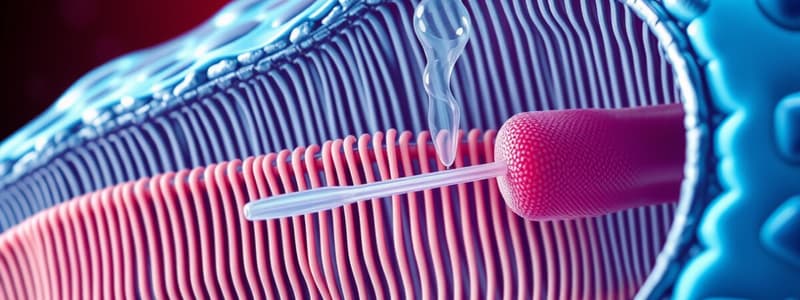Podcast
Questions and Answers
What is the primary function of transmembrane proteins?
What is the primary function of transmembrane proteins?
- Storage of genetic information
- Acting as channels and transporters (correct)
- Serving as structural components only
- Assisting in cell division
Active processes do not require energy input from the cell.
Active processes do not require energy input from the cell.
False (B)
What is the sugary coating surrounding the membrane made up of?
What is the sugary coating surrounding the membrane made up of?
Glycocalyx
The process by which substances move across cell membranes without the input of energy is called __________.
The process by which substances move across cell membranes without the input of energy is called __________.
Match the following membrane protein functions with their descriptions:
Match the following membrane protein functions with their descriptions:
Which factors influence the rate of diffusion across a membrane?
Which factors influence the rate of diffusion across a membrane?
The lipid bilayer is permeable to glucose.
The lipid bilayer is permeable to glucose.
What are the two types of transport processes mentioned in relation to membrane function?
What are the two types of transport processes mentioned in relation to membrane function?
What is the primary function of aquaporins in cellular transport?
What is the primary function of aquaporins in cellular transport?
Active transport requires energy to move substances against their concentration gradient.
Active transport requires energy to move substances against their concentration gradient.
What is the primary role of the sodium-potassium pump?
What is the primary role of the sodium-potassium pump?
In receptor-mediated endocytosis, specific ______ bind to receptors to initiate vesicle formation.
In receptor-mediated endocytosis, specific ______ bind to receptors to initiate vesicle formation.
Match the following types of endocytosis with their definitions:
Match the following types of endocytosis with their definitions:
Which of the following describes osmosis?
Which of the following describes osmosis?
Cilia are longer than flagella and help to move an entire cell.
Cilia are longer than flagella and help to move an entire cell.
What type of transport involves vesicles fusing with the plasma membrane to release contents?
What type of transport involves vesicles fusing with the plasma membrane to release contents?
Microtubules, microfilaments, and intermediate filaments are components of the ______ that provide structural support.
Microtubules, microfilaments, and intermediate filaments are components of the ______ that provide structural support.
Which structure consists of a network of membranes shaped like flattened sacs?
Which structure consists of a network of membranes shaped like flattened sacs?
What happens to a cell placed in a hypotonic solution?
What happens to a cell placed in a hypotonic solution?
Active transport does not require energy to move substances across the cell membrane.
Active transport does not require energy to move substances across the cell membrane.
Which organelle is referred to as the 'powerhouse' of the cell?
Which organelle is referred to as the 'powerhouse' of the cell?
The Golgi complex is responsible for producing ribosomes.
The Golgi complex is responsible for producing ribosomes.
What is the primary function of osmosis in cells?
What is the primary function of osmosis in cells?
The transport process where materials are brought into the cell is called __________.
The transport process where materials are brought into the cell is called __________.
What is the role of lysosomes in a cell?
What is the role of lysosomes in a cell?
Match the following transport mechanisms with their descriptions:
Match the following transport mechanisms with their descriptions:
The primary function of the __________ is to modify, sort, and package proteins.
The primary function of the __________ is to modify, sort, and package proteins.
Match the following cell structures with their primary functions:
Match the following cell structures with their primary functions:
Which of the following substances detoxifies several toxic substances, including alcohol?
Which of the following substances detoxifies several toxic substances, including alcohol?
Homologous chromosomes are two identical copies of a single chromosome.
Homologous chromosomes are two identical copies of a single chromosome.
What phase of the cell cycle involves the replication of DNA?
What phase of the cell cycle involves the replication of DNA?
The __________ phase of cell division involves the separation of sister chromatids.
The __________ phase of cell division involves the separation of sister chromatids.
How many pairs of chromosomes do human somatic cells contain?
How many pairs of chromosomes do human somatic cells contain?
What is the primary purpose of meiosis?
What is the primary purpose of meiosis?
Meiosis results in diploid cells.
Meiosis results in diploid cells.
How many chromosomes do haploid cells contain?
How many chromosomes do haploid cells contain?
Fertilization restores the ______ number of chromosomes.
Fertilization restores the ______ number of chromosomes.
What is the process of cytoplasmic division called?
What is the process of cytoplasmic division called?
Telophase is when two identical nuclei are formed.
Telophase is when two identical nuclei are formed.
What happens at the end of Meiosis I?
What happens at the end of Meiosis I?
Meiosis occurs in the ______ of the body.
Meiosis occurs in the ______ of the body.
Match the following phases of meiosis with their outcomes:
Match the following phases of meiosis with their outcomes:
What is the net result of performing Meiosis?
What is the net result of performing Meiosis?
Flashcards are hidden until you start studying
Study Notes
Cell Membrane and Transport
- Glycoproteins are membrane proteins with carbohydrate groups that extend into extracellular fluid.
- Glycocalyx is a sugary coating made from carbohydrate portions of glycolipids and glycoproteins, crucial for cell recognition and protection.
- Transmembrane Proteins function as channels and transporters for substances like glucose and ions.
Transport Mechanisms
- Passive Processes: Movement across cell membranes without energy input; relies on kinetic energy of molecules (e.g., diffusion).
- Active Processes: Involves energy from ATP breakdown to move substances against concentration gradients.
Diffusion Factors
- Concentration Gradient: Steeper gradients increase diffusion rate.
- Temperature: Higher temperatures enhance molecular movement.
- Mass: Lighter molecules diffuse faster.
- Surface Area: Larger areas facilitate more diffusion.
- Distance: Shorter distances speed up the process.
Membrane Permeability
- Cell membranes vary in permeability; lipid bilayers allow passage for small uncharged molecules (e.g., O₂, CO₂, H₂O).
- Osmosis is the movement of water through a selectively permeable membrane from higher to lower water concentration.
Vesicular Transport
- Endocytosis: Cells intake materials via vesicle formation from the plasma membrane.
- Types:
- Receptor-mediated endocytosis.
- Phagocytosis (cellular eating).
- Bulk-phase endocytosis (pinocytosis, cellular drinking).
- Types:
- Exocytosis: Vesicles fuse with the plasma membrane to release contents outside the cell.
- Transcytosis: Combines endocytosis and exocytosis for transference of materials.
Cytoplasm Components
- Cytosol: Intracellular fluid where chemical reactions occur and maintains cell shape.
- Organelles:
- Ribosomes: Protein synthesis sites.
- Endoplasmic Reticulum: Network of membranes for protein (Rough ER) and lipid (Smooth ER) synthesis.
- Golgi Apparatus: Modifies, sorts, and packages proteins.
- Lysosomes: Contain enzymes for digestion of cellular waste.
- Peroxisomes: Detoxify substances like alcohol; abundant in the liver.
- Mitochondria: ATP producers, crucial for energy generation.
Cell Division
- Mitosis: Somatic cell division producing two identical daughter cells; involves stages: Prophase, Metaphase, Anaphase, Telophase.
- Interphase: Non-dividing stage where DNA is replicated.
- Meiosis: Reproductive cell division producing gametes with half the chromosome number; results in four genetically diverse haploid cells.
Membrane Solutions and Tonicity
- Isotonic Solutions: Equal solute concentrations; cells maintain normal shape.
- Hypotonic Solutions: Lower external solute concentration; may cause cells to swell and burst.
- Hypertonic Solutions: Higher external solute concentration; can cause cells to shrink due to water loss.
Active Transport Overview
- Requires energy to move substances against their concentration gradient.
- Na+/K+ Pump: Moves sodium out and potassium into cells, essential for maintaining membrane potential and cellular homeostasis.
Studying That Suits You
Use AI to generate personalized quizzes and flashcards to suit your learning preferences.




